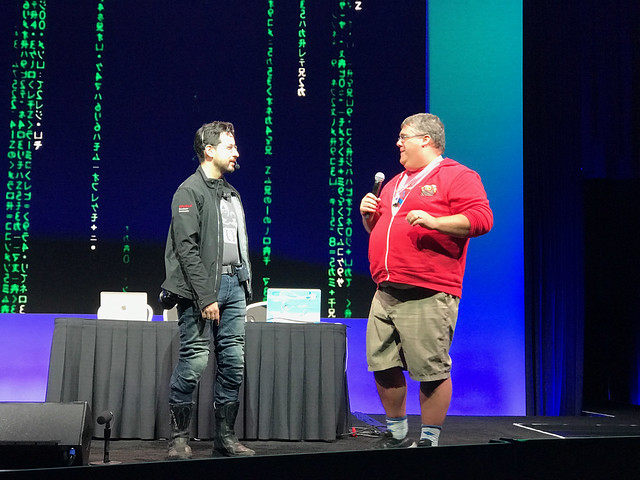The JavaOne Community Keynote started with IBM talking about and demonstrating its latest contributions to open source: OpenJ9, Open Liberty, and MicroProfile. John Duimovich, IBM distinguished engineer, kicked things off with a presentation titled "IBM and Java: Powering the next generation of innovation".
You can watch the IBM Keynote via the embedded video below.
Duimovich said IBM is driving innovation in the Java ecosystem, because the cloud has forced them to. Innovative changes are necessary for cloud native development. Because seeing is believing, brought Alasdair Nottingham on stage to do a demo of J9, all of Open Liberty, and MicroProfile.
Nottingham showed off an application called "Acme Gifts" that you can find on GitHub. He demonstrated how you could provide resilience with Hystrix and fallback methods, then killed the Docker container to prove everything worked.

You can see an InfoQ interview with Nottingham in IBM Introduces Open Liberty, an Open Source Runtime for Java Microservices.
Duimovich talked about IBM Cloud private, a full environment for developers. He called it "a cloud for dev rather than just cloud for ops" and thinks it will become more prevalent in the future.
IBM open sourced J9, their Java virtual machine which they claim is “cloud and microservices optimized" with support for packed objects, multitenancy, AOT, GPU, and shared classes with more to come.
Duimovich said that in their tests J9 has a 2x smaller memory footprint and starts 2x faster than HotSpot.
To showcase our performance pedigree we set about measuring the strengths of OpenJDK with Eclipse OpenJ9 compared to an OpenJDK with Hotspot. We chose the Daytrader3 application because it is meaningful to measure different performance metrics, unlike many microbenchmarks that focus almost exclusively on throughput. The metrics we focused on include startup time, the JVM footprint size during the experiment, and of course, throughput.
Ian Robinson then took to the stage to talk about open innovation and microservices.
Microservices and cloud platforms have changed the role of the application container. Developers need well-defined application-centric capabilities. They need their apps to be packaged by continuous integration and continuous deployment. Basically, you need a CI/CD pipeline, running in lightweight virtualized containers, that's wired to cloud platform capabilities for routing, management, scaling, and fault tolerance.

Java EE got a reputation for being monolithic even though there are many good examples of not being monolithic, such as TomEE, WildFly, etc. As long as Jave EE apps can be packaged into a cloud-ready deployment unit, it will continue to succeed. With Liberty, we did everything that our developers asked us to do.

IBM donated 3.5 million lines of code with Open Liberty. All of the ongoing WebSphere development is going into Open Liberty. You can run it in production with an EPL license and get support for it via a WebSphere license.
Open Liberty is a modular runtime, built from from the ground up. One thing that makes it different from other runtimes is its configuration model. Developers love to innovate, but introducing innovation into a data center can be a scary thing. You can introduce new features into Open Liberty without taking away the old stuff.
Robinson announced Microservice Builder, a site that helps you build microservices with Docker, Git, and Bluemix CLI. It also demonstrates how to do continuous delivery of containerized microservices in a Kubernetes environment.

For Java EE to remain relevant, it has to move forward and innovate rapidly.
Robinson introduced John Clingan, a senior principal product manager at Red Hat and the Eclipse MicroProfile co-lead.

Clingan observed that the cadence of Java EE releases was slowing. It was mature and great for delivering monolithic applications. A lot of vendors started creating lightweight runtimes. Rather than experimenting separately, they got together with other vendors and created MicroProfile to collaborate on microservice APIs.
They joined the Eclipse Foundation for transparency, openness, and to level the playing field.
The MicroProfile community has already gone through the process and they hope to help Java EE make the transition. But they'll continue to work on MicroProfile. They're going to need help aligning with EE4J. They might submit JSRs or they might fold MicroProfile into EE4J. Please contribute and let them know how they should work together!
"Thanks to all of you!", said Robinson.

After IBM, Stephen Chin took the stage to finish the Java Community Keynote. He showed his video from the Oracle Code Japan motorcycle tour last year, then invited Kevin Nilson on stage, from the Silicon Valley JUG. If you were at last year's JavaOne, you know this was a touchy moment. The audience laughed and smiled.
You can watch the Community Keynote with Chin (and many actors) via the video below, or simply watch the highlights.
Chin started a dialog with Nilson, telling him that they were filming a movie and they needed everyone to leave. For the next hour, Chin and a whole slew of Java community members took the stage to act in a movie similar to The Matrix. There was lots of laughs, awkward moments, and familiar faces on stage. I took notes of dialog that ensued, but it's not nearly as good as watching the full video.
If you're in a hurry, I did take a number of pictures that might help you visualize the fun that ensued.
There’s also a highlight reel from the Oracle Code Keynote on Tuesday. You can watch all the recorded sessions for Oracle Code on this playlist.
Learn More
InfoQ reported on all the keynotes at JavaOne 2017. You can see Monday and Tuesday's keynote summaries at the links below.

